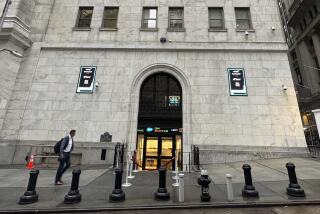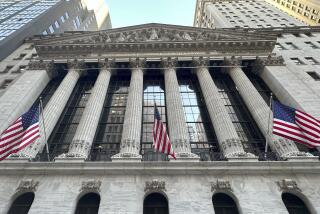Bullish Finish : Propelled by Hopes for Lower Rates, Stocks Have Good Quarter
Wall Street closed out a winning quarter Monday, again foiling the bears--and the reluctant bulls--who expected stock prices to pull back sharply in summer.
With the economy struggling and a significant rebound in corporate earnings unlikely soon, more investors appear to be hanging all of their hopes for stocks on a continuing slide in interest rates.
That may be an increasingly dangerous game, experts say. Yet they also admit that it’s a strategy that can pay off for a surprisingly long time.
Monday, the Dow Jones industrial average inched up 10.73 points to 3,016.77, finishing the third quarter with a gain of 110.02 points, or 3.8%. That followed a first-half rise of 10.4% for the blue chip index.
But the Dow once again was a sideshow to the much wilder action elsewhere on Wall Street:
* Small stocks, as measured by the NASDAQ composite index of over-the-counter issues, jumped 10.7% on average in the quarter. Year to date, the NASDAQ index is up a stunning 40.9%.
* The Standard & Poor’s Mid-Cap index, which tracks prices of 400 medium-size companies, surged 8.9% for the quarter.
* The yield on 30-year Treasury bonds, a benchmark for other rates, tumbled from 8.41% at the end of June to 7.8% at the close Monday--the lowest since March, 1987. Bond yields have fallen as the Federal Reserve has eased credit to try to spark the weak economy.
Most stock market indexes finished the quarter just below their all-time highs reached in recent weeks. The Dow, for example, peaked at 3,055.23 on Aug. 28, in the euphoria that followed the failed Soviet coup attempt.
For much of the quarter, the Dow gyrated in a narrow range of 2,900 to 3,050. That relatively dull performance pushed more investors to hunt for better opportunities in the already frothy small-stock arena.
The fading allure of alternative investments such as money funds, bank CDs and gold also helped power stocks, even though Wall Street pros have cautioned that the market is trading at or near dangerous heights relative to earnings, dividend payouts and other historical measures of value.
For many investors, the ongoing attraction of the stock market is rooted in one great hope: that interest rates will drop even lower, eventually igniting an economic recovery and higher corporate profits.
Experts say the market’s psychology may be akin to that which appears to be keeping the Soviet Union from exploding: the feeling that things aren’t all right now but that they will be later.
On Wall Street, that translates into a general reluctance to sell stocks and a strong desire to chase “hot” stock ideas even when prices have already soared through the roof.
“There’s a great tendency to lower your guard at times like this and just assume the market will be OK,” says Albert Nicholas, a veteran money manager at the Nicholas Funds in Milwaukee. “I think people are mesmerized that the market holds up day after day, and that’s dangerous.”
Indeed, the market has shown in recent days how angry it can turn when the disappointment level crosses a certain threshold. Last Friday, shares of Laguna Hills-based Community Psychiatric plunged $6.25 to $17.25 after the company said its quarterly earnings had plummeted because of billing problems.
Wall Street’s most bearish analysts believe that the same fate awaits the market as a whole, if the economy--and thus profits--fail to show renewed growth in the months ahead.
But other experts say that no substantial selloff is probable soon, even with an anemic economy, so long as lower interest rates provide a margin of hope for investors bored with paltry returns on other financial options.
Of course, even as the broad market holds up, much is going on under the surface. In the third quarter, investors flocked to many beaten-down stock groups, such as banks and brokerages, looking for bargains before any economic revival.
At the same time, shares of auto companies, airlines and some other groups were dumped as investors grew impatient with lagging profits or as they grew fearful that stocks that had provided steady earnings growth may no longer do so--as in the case of some grocery chains.
Still, stocks overall continue to attract enough new investors that the broad market keeps moving higher, with only modest setbacks. Mark Lipson, president of the National Funds mutual fund firm in Greenwich, Conn., sees at worst a dip of 5% to 10% in key stock indexes during the next six months, as Wall Street waits on the economy.
Nicholas, too, doubts that a severe selloff will occur. Though stocks are fully priced relative to near-term earnings hopes, history has shown that “they can stay fully priced for a long time.”
What’s more, some small-stock experts insist that prices of those issues are far from peaking, despite the huge gains this year.
Claudia Mott, who tracks small stocks for Prudential Securities in New York, says much of the strength in small stocks this year has been concentrated in the better-known issues, leaving many truly small stocks untouched.
And even though the NASDAQ index is up almost 41% this year, that follows an 18% drop last year in the bear market, Mott notes. Far from soaring out of control, so far “small stocks are just making up a lot of the ground they lost,” she says.
Mott believes that small companies’ third-quarter earnings will look far better than earnings of bigger companies, partly because smaller firms have been able to adjust faster to the tough economy. She forecasts an 11.5% average profit gain versus the third quarter of 1990 for the small-stock universe she tracks. In contrast, Prudential sees profits down 6% in the quarter for the S&P; 500 index of big stocks.
Small Stocks Lead Again Third-quarter and year-to-date gains for key stock index: NASDAQ composite Quarter: +10.7% Year-to-date: +40.9% S&P; 500 Quarter: +4.5% Year-to-date: +17.5% Dow Industrials Quarter: +3.8% Year-to-date: +14.5% . . .as Interest Rates Tumble. . . 30-year Treasury bond yield Monday close, 7.80% . . .and Other Investments Fade
3rd Qtr. Investment June 30 Monday Change Gold (ounce) $368.10 $354.00 -3.8% Silver (ounce) $4.42 $4.13 -6.6% U.S.dollar (in German marks) 1.81 1.66 -8.3% Money market fund average 5,48% 5.18% -0.30 yield pts.
Third Quarter’s Best and Worst Stock Groups
Here are the 10 best- and 10 worst-performing stock industry groups in the third quarter, through Friday, measured by average percentage change of the stocks in each group. The broad market, measured by the S&P; 500 index, rose 4.5% for the quarter.
Biggest Gainers
Industry Group Pct. change Shoes +36.4% Personal loans +21.9% Big banks (outside N.Y.C.) +20.1% Housewares +18.7% Financial (misc.) +18.2% Health care (misc.) +16.3% Specialty retailers +15.8% Railroads +15.0% Bottle/can makers +14.2% Major N.Y. banks +13.6%
Biggest Losers
Industry Group Pct. change Gold mining -14.5% Autos -13.9% Grocery chains -12.6% Semiconductors -10.3% Machine tools -9.1% Transportation (misc.) -8.7% Property/cas. insurance -8.2% Airlines -7.8% Engineering/construction -7.8% Hospital management -7.8%
Source: Smith Barney, Harris Upham & Co., using S&P; indexes
More to Read
Inside the business of entertainment
The Wide Shot brings you news, analysis and insights on everything from streaming wars to production — and what it all means for the future.
You may occasionally receive promotional content from the Los Angeles Times.










